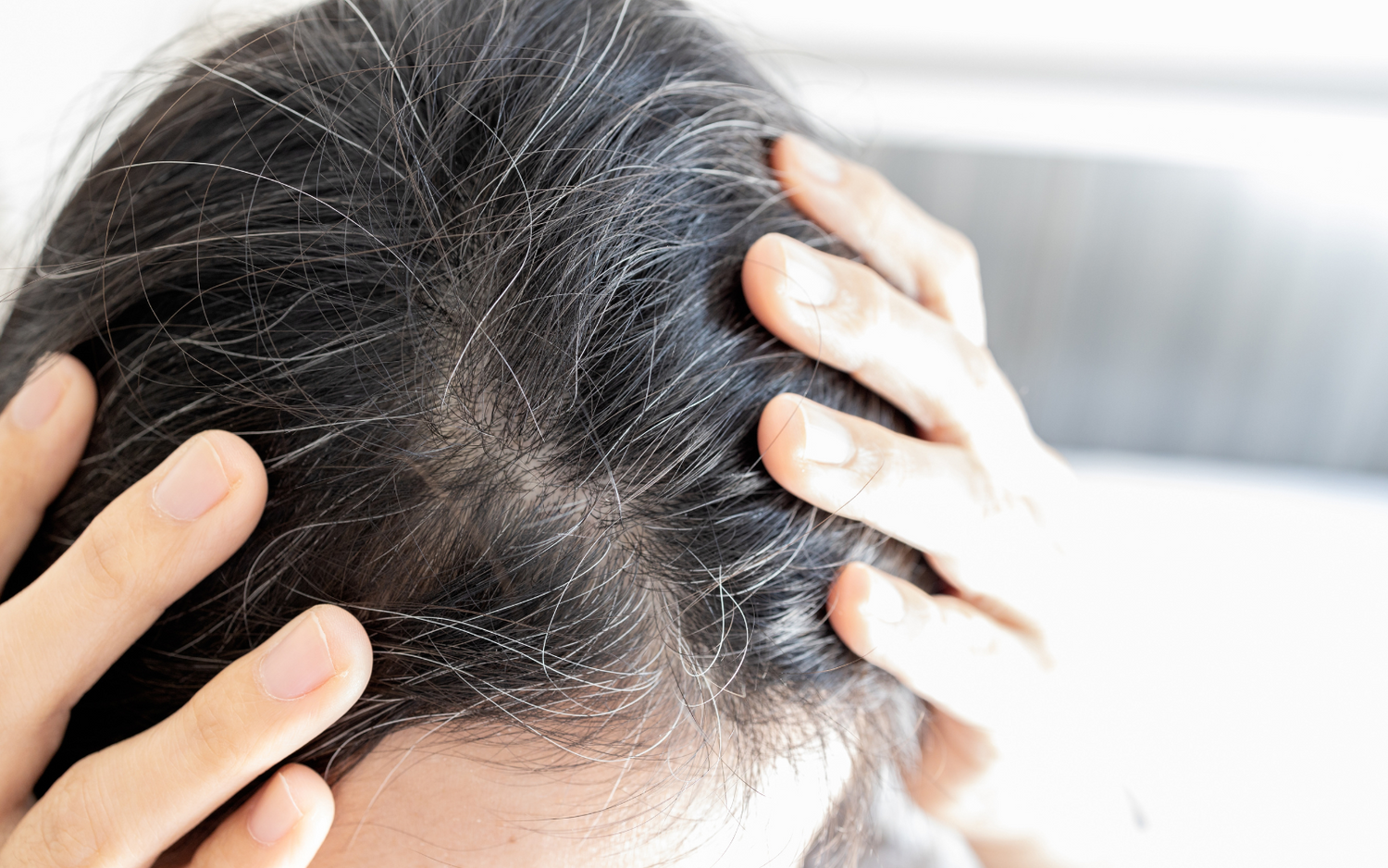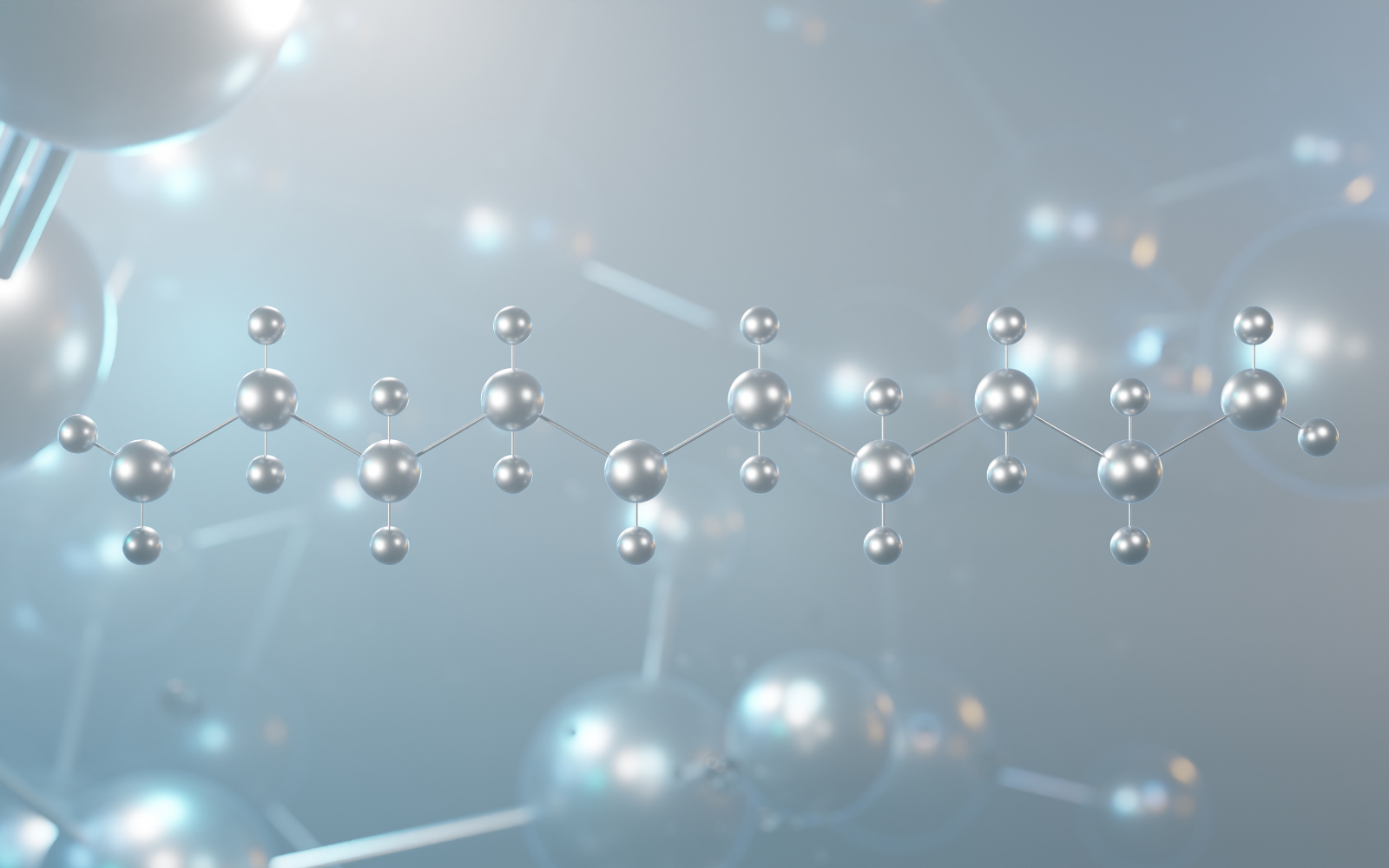As you probably know, gray hair is a common side effect of getting older. But why does this happen, and is it inevitable or can it be prevented and even, reversed?
To understand this process, let's start with how your hair gets its color in the first place. The roots of every hair on your head are surrounded by tissue, aka your hair follicles, which contain an abundance of pigment cells known as 'melanocytes' [1]. These pigment cells are responsible for coloring hair, producing a chemical known as melanin.
Melanin is well known for controlling your skin tone and how prone you are to tanning, but it also determines, in combination with genetic code, your unique hair color. As you age and your body struggles to keep up with cell turnover, this pool of melanocytes diminishes, in turn reducing the pigmentation supply to hair strands. Research suggests that beyond 30 years of age there is a 10-20% per decade reduction [2] in active melanocytes, resulting in the silvery/gray hair color we know well. This degeneration of the hair follicle is the consequence of both environmental and endogenous effects of aging, from sun exposure to stress levels to oxidative stress and overall biological age. And one thing these factors have in common is that they are in many cases reversible and preventable.
Causes of Gray Hair
Oxidative Stress
Oxidative stress is an imbalance between the production and accumulation of reactive oxygen species (ROS) and your body's ability to produce an antioxidative response [3]. ROS are generally produced by your body (due to your metabolism) or environmental stressors and, if levels are not controlled, can cause cell and tissue damage - in this context, to your hair follicles [4].
Stress Levels
Recent studies discuss the link between high stress levels and gray hair. Your sympathetic nervous system, responsible for your 'fight or flight response' releases the chemical 'norepinephrine' in times of high stress. This chemical release can extend to the hair follicles and be converted to hydrogen peroxide (which is what they would use in the salon to color your hair blonde!) This increased production of hydrogen peroxide can affect melanocyte stem cells, which is detrimental to the production of new pigment cells, which would come out gray or white as a result!
Vitamin & Mineral Deficiencies
Deficiencies in, for example, vitamin B12/B6, iron, vitamin D and vitamin E play a role in speeding up the gray hair process [6]. Often this is due to nutritional implications and can be restored through diet/vitamin supplementation.
Other Factors:
- Certain medical conditions (e.g. autoimmune diseases, thyroid dysfunction)
- Smoking
- Chemical hair dye (hydrogen peroxide)
- Genetic predisposition
- Low glutathione levels
- Poor spermidine production, which decreases with age
So, if the process behind graying hair and factors affecting it are relatively well understood, can this process be reversed or prevented?
Spermidine and Gray Hair Reversal
Spermidine, a polyamine with myriad anti-ageing properties. is a strong candidate for gray hair reversal. Emerging evidence for its ability to move hair follicles into the growth phase (where melanogenesis takes place), anti-oxidative properties, power to induce autophagy (cell renewal) and even positively affect general mood and stress levels point towards its potential to target the causative factors of gray hair listed above [6].
Increased Melanin Production
Primarily, studies have shown the potential of spermidine and putrescine (the precursor to spermidine) as a natural pigmentation agent [7], increasing melanin production from melanocytes in a dose dependant manner. Furthermore, polyamines (spermidine, spermine and putrescine) may increase melanocyte integrity and help them regenerate. They have been discussed as key mediators of cell function [8], including proliferation, migration and differentiation, which helps to prevent melanocyte depletion. Its known autophagy-inducing [9] properties add to this by helping to recycle and restore these key pigment-producing cells.
Anti-Oxidative Properties (Hydrogen Peroxide Regulation)
Regarding oxidative stress, polyamines have been shown to restore oxidative homeostasis through either acting as alternative substrates for enzymes producing ROS (suppressing ROS production) or up-regulating antioxidant systems within the body.
More specifically, spermidine and spermine have also been shown to protect against oxidative damage caused by hydrogen peroxide [10]. This protective capability was highlighted in a study with spermine- and spermidine- depleted cells showing a marked increase in sensitivity to hydrogen peroxide damage compared to cells with normal or supra physiological levels of these polyamines. This is particularly relevant when looking at gray hair reversal, showing its potential to mediate and prevent some of the factors listed above: life- and environmental- stress and chemical hair dye induced graying.
Vitamins, Mineral and Other Nutrients
If you're looking for additional, easy ways to delay the graying process, it is important to consider your diet. Particular vitamins and minerals help increase melanin production from the hair follicle, retaining your natural color for longer.
These include:
- Vitamin B5, B6, B9, B12, D
- Calcium
- Copper
- Zinc
- Fish oil
- Iron
- Protein (Keratin)
- Biotin
Plant-Derived Spermidine Supplements:
Based on this research, upping your spermidine, spermine and putrescine levels could be another great way to target gray hair...
Primeadine is a pure, wholly plant-derived spermidine supplement - Primeadine Original is made from concentrated Japanese wheat germ extract and Primeadine GF from a unique blend of Okinawan chlorella, turmeric and "Shikuwasa" or citrus lime peel. As it is food-derived, the spermidine is highly bioavailable.
Primeadine Original adds to this with a unique prebiotic fiber called FOS which reactivates your body's natural ability to make spermidine and by containing all 3 polyamines mentioned above: spermidine, spermine, and putrescine, which are involved in a virtuous recycling loop to make more of each other. Primeadine GF contains spermidine and putrescine as well as 2 other autophagy inducers and antioxidants: nobiletin and turmeric.
Attesting to this, we have valuable testimonies from our clients that have seen visible improvements in their hair, seeing new growth of colored hair strands and gray hair reversal.
If you are interested in more information for improving your hair health and seeing success stories, check out Leslie Kenny's (founder of Oxford Healthspan) youtube videos at Leslie's New Prime:
Gray Hair Reversal Success Stories with Spermidine
References
[4] Trüeb RM. Oxidative stress in ageing of hair. Int J Trichology. 2009 Jan;1(1):6-14. doi: 10.4103/0974-7753.51923. PMID: 20805969; PMCID: PMC2929555.





Leave a comment
All comments are moderated before being published.
This site is protected by hCaptcha and the hCaptcha Privacy Policy and Terms of Service apply.